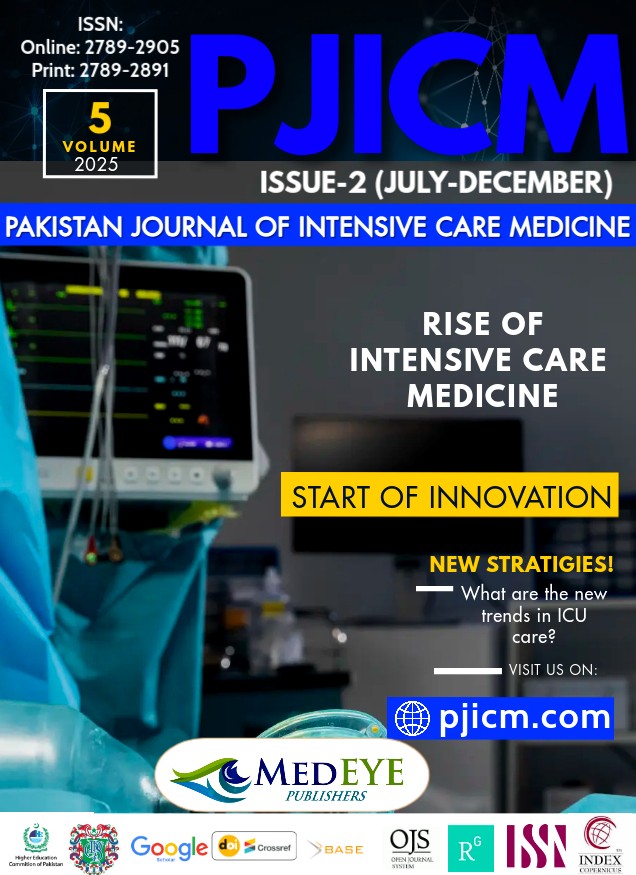MOLECULAR IDENTIFICATION OF ESCHERICHIA COLI STRAIN ISOLATED FROM URINARY TRACT INFECTIONS AT A TERTIARY CARE HOSPITAL IN SIALKOT, PAKISTAN
DOI:
https://doi.org/10.54112/pjicm.v5i02.180Keywords:
Urinary Tract Infection, Antibiotic Resistance, Molecular identification, 16S rRNA sequencing, SialkotAbstract
Background: Urinary tract infections (UTIs) caused by Escherichia coli remain a primary global health concern, with increasing multidrug resistance posing significant diagnostic and therapeutic challenges. Molecular techniques such as 16S rRNA sequencing provide a reliable approach for accurate identification and phylogenetic characterization of resistant strains. Objective: To isolate and identify multidrug-resistant (MDR) Escherichia coli strains from urinary tract infection patients in District Sialkot, Pakistan, using 16S rRNA sequencing. Study Design: Cross-sectional molecular study. Setting: Department of Microbiology, tertiary care hospital in Sialkot, Pakistan. Duration of Study: From July 2023 to December 2023. Methods: Twenty E. coli isolates were obtained from urine samples of patients with clinically diagnosed UTIs. Identification was performed using standard microbiological techniques. Antibiotic susceptibility testing was conducted using the Kirby–Bauer disc diffusion method against commonly used antibiotics. The isolate exhibiting multidrug resistance was subjected to molecular identification via 16S rRNA gene sequencing and phylogenetic analysis. Sequence data were compared with reference strains using BLAST and submitted to GenBank. Results: Antibiotic susceptibility testing revealed high levels of resistance to ceftriaxone (95.2%), cefoperazone (93.5%), ciprofloxacin (86.5%), cefotaxime (84.6%), and cefixime (86%). Molecular analysis confirmed the isolate as Escherichia coli, with phylogenetic analysis showing close homology to previously reported E. coli strains. The sequence of the multidrug-resistant strain was submitted to GenBank under the accession number Escherichia coli strain KS8861 (PP897401.1). Conclusion: 16S rRNA sequencing serves as a robust and accurate method for identifying multidrug-resistant E. coli strains associated with UTIs. Incorporating molecular diagnostics into routine microbiological workflows can enhance early detection and guide effective antimicrobial therapy.
References
Zagaglia C, Ammendolia MG, Maurizi L, Nicoletti M, Longhi C. Urinary tract infections caused by uropathogenic Escherichia coli strains—new strategies for an old pathogen. Microorganisms. 2022;10(7):1425. https://doi.org/10.3390/microorganisms10071425
Alshaikh SA, El-Banna T, Sonbol F, Farghali MH. Correlation between antimicrobial resistance, biofilm formation, and virulence determinants in uropathogenic Escherichia coli from Egyptian hospitals. Ann Clin Microbiol Antimicrob. 2024;23(1):20. https://doi.org/10.1186/s12941-024-00679-2
Walker MM, Roberts JA, Rogers BA, Harris PN, Sime FB. Current and emerging treatment options for multidrug-resistant Escherichia coli urosepsis: a review. Antibiotics (Basel). 2022;11(12):1821. https://doi.org/10.3390/antibiotics11121821
Halaji M, Fayyazi A, Rajabnia M, Zare D, Pournajaf A, Ranjbar R. Phylogenetic group distribution of uropathogenic Escherichia coli and related antimicrobial resistance pattern: a meta-analysis and systematic review. Front Cell Infect Microbiol. 2022;12:790184. https://doi.org/10.3389/fcimb.2022.790184
Bastidas-Caldes C, Hernández-Alomía F, Almeida M, Ormaza M, Boada J, Graham J, et al. Molecular identification and antimicrobial resistance patterns of Enterobacterales in community urinary tract infections among indigenous women in Ecuador: addressing microbiological misidentification. BMC Infect Dis. 2024;24(1):1195. https://doi.org/10.1186/s12879-024-10096-7
Čeprnja M, Oros D, Janeš A, Žučko J, Barišić K, Škrlin J, et al. Systematic review—how do we identify urinary tract infections today? Open J Bacteriol. 2023;7(1):1–10. https://doi.org/10.17352/ojb.000023
Srinivasan R, Karaoz U, Volegova M, MacKichan J, Kato-Maeda M, Miller S, et al. Use of the 16S rRNA gene for the identification of a broad range of clinically relevant bacterial pathogens. PLoS One. 2015;10(2):e0117617. https://doi.org/10.1371/journal.pone.0117617
Sevigny JL, Rothenheber D, Diaz KS, Zhang Y, Agustsson K, Bergeron RD, et al. Marker genes as predictors of shared genomic function. BMC Genomics. 2019;20(1):268. https://doi.org/10.1186/s12864-019-5641-1
Sherchan JB, Dongol A, Humagain S, Joshi A, Magar SR, Bhandari S. Antibiotic susceptibility pattern of bacteria causing urinary tract infection. J Nepal Health Res Counc. 2022;20(1):218–24. https://doi.org/10.33314/jnhrc.v20i01.4142
Clinical and Laboratory Standards Institute (CLSI). Performance standards for antimicrobial susceptibility testing; twenty-first informational supplement. CLSI document M100-S21. Wayne (PA): CLSI; 2011.
Jaaz WS. Molecular detection of 16S rRNA gene in Escherichia coli isolated from urinary tract infection patients. EurAsian J BioSci. 2020;14(1):99–104.
Zhou Y, Zhou Z, Zheng L, Gong Z, Li Y, Jin Y, et al. Urinary tract infections caused by uropathogenic Escherichia coli: mechanisms of infection and treatment options. Int J Mol Sci. 2023;24(13):10537. https://doi.org/10.3390/ijms241310537
Sabir S, Anjum AA, Ijaz T, Ali MA, Nawaz M. Isolation and antibiotic susceptibility of E. coli from urinary tract infections in a tertiary care hospital. Pak J Med Sci. 2014;30(2):389–92. [No DOI]
Karigoudar RM, Karigoudar MH, Wavare SM, Mangalgi SS. Detection of biofilm among uropathogenic Escherichia coli and its correlation with antibiotic resistance pattern. J Lab Physicians. 2019;11(1):17–22. https://doi.org/10.4103/JLP.JLP_98_18
Niranjan V, Malini A. Antimicrobial resistance pattern in Escherichia coli causing urinary tract infection among inpatients. Indian J Med Res. 2014;139(6):945–8.
Lakshmi P, Bharadwaj A, Srivastava RK. Molecular detection and identification of bacteria in urine samples of asymptomatic and symptomatic pregnant women by 16S rRNA gene sequencing. Arch Clin Infect Dis. 2020;15(3):e101136. https://doi.org/10.5812/archcid.101136
Downloads
Published
How to Cite
Issue
Section
License
Copyright (c) 2025 K SHEHZADI , R ADALAT , U NISAR , S ILYAS , H AMJAD , H EHSAN , F IQBAL, S ALYAS

This work is licensed under a Creative Commons Attribution-NonCommercial 4.0 International License.












